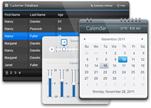Kendo UI Q1 Beta Release
As an evangelist for Kendo UI, I get to talk about awesome stuff all the time. Awesome is par for the course. Awesome is what I work with every day. And you might be thinking to yourself, “Sure, of course you think it’s awesome. That’s your JOB fella”.
And this is true, it is indeed my job.
However, yesterday we dropped a beta release of Kendo UI that is jaw dropping. I work here and I was blown away when I finally got to see all of the bits working in action on the demos. I’m honestly at a loss as to how I can convey how good this really is with words, but here goes nothing…
Let’s Do It
As you may know by now, there are 3 parts to Kendo UI. Web, DataViz and Mobile. There is new flare literally EVERYWHERE. Not “we made the tabs better”, or “we added an event to the dropdown” changes - but major new widgets and framework enhancements. Starting with..
 Kendo UI Web
Kendo UI Web
The grid showed up on day 1 as a full featured widget, but the Q1 beta takes it to the HNL
Editor Customization
You can now specify a template for your editing experience to make use of other Kendo UI widgets thusly restricting input to valid values only. A better experience for your users, and less input validation for you.
Popup Editor
Inline editing has been around since the initial launch, but the grid now features a popup editor in addition to inline editing. Use whichever suits your project best.
The popup editor displays a new window for editing a row. These windows can contain other widgets for editing, such as drop downs and checkboxes. Combined with a customer editor template, this gives you absolute control over the editing experience.
Aggregates
In addition, the grid now has the ability to deal with aggregates, meaning you can now display summaries in your grids including count, sum, min, max and average. This automatically creates summary data inside of your grid. Without you having to do any extra work. Combined with current grid features like grouping and sorting, this puts true Excel like power in your grid.
Display your data how you want to and let your users interact with it the way they want to.
The ListView is a brand new widget for a very common type of layout that is difficult to support when you are creating it from scratch. Often, you want to layout items in a grid format without them actually being inside of a Grid Widget. This happens a lot when dealing with images or sections of related data that you want displayed inline.
The new ListView widget handles the layout for you as well as providing selection, editing, navigation and even paging.
If you have been working with heavy JavaScript front-ends, then you know how painful it can be to try and manage the state of your UI and also keep your underlying data model in sync. There are several patterns and frameworks that make this much easier. One of the common patters is the Model View View-Model pattern; commonly referred to as MVVM.
MVVM provides two way data bindings between your UI and your data models. This beta release introduces a full MVVM framework baked right into Kendo UI. That means that as your UI changes, so do your underlying Kendo UI DataSource Models. It’s hard to fully grasp the power that this gives you without seeing it in action and implementing it for yourself.
We have gone to great lengths to design our MVVM implementation in a way that is intuitive and works seamlessly with our widgets. This new piece of Kendo UI is worth an entire series of blog posts just on its own.
The best way for you to experience this is to head over to the demos and have a look for yourself.
If you have prior experience with an MVVM framework such as KnockoutJS and are wondering why we went to such an extend as to roll our own, make sure you read this post. This has been well thought out with help from the community and executed with extreme care and planning.
